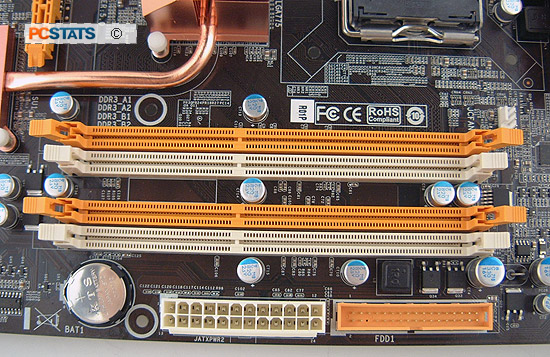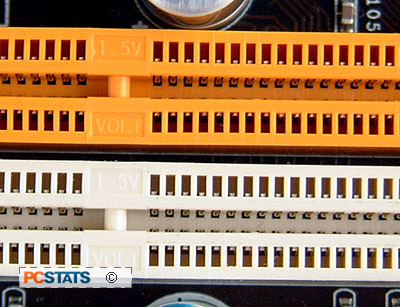As your geek friend has probably told you, desktop computer memory
is in a transitory phase, moving from DDR2 RAM to DDR3 RAM. No one expects
DDR3 to really take hold until next year, when quad-core processors sprout up like
veritable weeds on the PC landscape.
For the
time being a strange situation exists where motherboard makers are releasing identical Intel P35
Express boards, save the memory standard they adopt; either DDR2 or DDR3. By
mid to late 2008 however, the DDR3 memory standard should account for at
least half the Intel motherboard market, if not more. It's hard to say where AMD will
fall in with all of this, its 'K10' microprocessor architecture is not expected
to adopt DDR3 RAM until 2009.
Differences in memory: DDR2 and DDR3 are not
interpretable
As with
all new standards, it's important to state the obvious right from the start to
minimize confusion. Computer RAM has been around for many years now, and in
our time PCSTATS has seen it transition from SDRAM to DDR, and from
DDR to DDR-2 memory. It’s important to note that while DDR2 and
DDR3 Dual Inline Memory Modules (DIMMs) are physically the same size, and contain the same
number of little gold connector pins (240), the modules are keyed at
different spots and are not interchangeable.
DDR3 RAM will not work in a DDR2 motherboard even
if the chipset is technically DDR3 compatible (ie. Intel P35 Express). Conversely, a DDR3 motherboard
is not backwards compatible with DDR2 memory modules... despite your best intention to
reuse those once very expensive puppies.
|

These are
1.5V DDR3 memory slots (above), and below you can see a
DDR3 memory module over top of a DDR2 module. Note the subtle difference where
the DDR3 module is 'keyed' with respect to the DDR2
module. Both memory standards have exactly 240 gold connectors, but DDR3
operates at 1.5V, DDR2 at 1.8V.
 |
New memory standards are almost always made incompatible
with old ones for a couple of very important
reasons... Voltage and data transfer architectures are usually to blame. Surprisingly, prying more money
out of your wallet by forcing you to buy completely new hardware doesn't technically factor
in.
|

Placed edge to edge, it is easy
to see the physical difference between DDR2 and DDR3 modules rests with where that
small key space is positioned. It prevents DDR2 memory from
being installed in a DDR3 motherboard and vice versa. The pins
as may notice, line up perfectly.
|
The main difference between DDR-3 memory and its
predecessor is that DDR3 operates with less voltage. DDR-3 RAM
runs with 1.5V, while DDR2 demands a little more, 1.8V. Next, unique  memory slots prevent you from running DDR3 memory in a DDR2 memory slot
and vice versa. The memory standards themselves are not inter-compatible, so
neither are the sockets.
memory slots prevent you from running DDR3 memory in a DDR2 memory slot
and vice versa. The memory standards themselves are not inter-compatible, so
neither are the sockets.
But system memory is system memory right? Yes, but not
quite. Think of it like coffee and tea. Each beverage requires a specialized
preparation and brewing method, but the end result in both situations is a hot
caffeinated liquid. If you try to brew coffee in a tea pot, or tea leaves in an
espresso machine... well, neither works.
On top of the key
differences, JEDEC standards dictate desktop DDR2 memory speeds to between 400-800 MHz, although chipset and
memory manufacturers have pushed DDR2 speeds much further.
Intel’s P35 Express chipset for example, will
run DDR2 memory as high as 1066 MHz.
The JEDEC standards for DDR3 memory on the other hand
start at 800 MHz and currently run as high as 1600 MHz. While there is
a bit of overlap in terms of speeds, that is not likely to last. At the moment most
DDR3 memory comes in two flavors, 1066 and 1333 MHz, but the
speeds will increase as the memory standard matures.
DDR3 vs DDR2 Memory Performance?
The quick and simple explanation is that at the same
speeds, DDR2 and DDR3 desktop memory will perform roughly the same. In the long term
DDR3 memory should take the lead. Manufacturers will eventually increase bus speeds and
memory operating frequencies to meet the memory bandwidth demands of the
next generation quad and multi-core processors, and demanding computer users
of course. ;-)
Next up, PCSTATS
speaks about the Intel P35 Express chipset. Is it Intel's best
and brightest, or just a mainstream stop-gap until the Intel
X38 Express arrives?
